In the Studio With Black Boy Knits Designer Jacques Agbobly
VMAN chats with the creative about their energetic knitwear brand, breaking into the industry, and channeling the duality of their identity through design

In the heart of Williamsburg, Brooklyn, 2022 CFDA/Vogue Fashion Fund Finalist and recent winner of the CFDA DHL Logistics Award, Jacques Agbobly is outside their studio in a newly designed vibrant green sweater, sun-kissed and grateful to be here.
Agbobly attended Parsons School of Design, developing a sartorial world in homage to their homeland Togo, Africa, and their intersecting Black and queer identities. It’s imperative for designers today to know the story they are going to tell, and Agbobly tells one with nostalgia, longing, and love through their bourgeoning knitwear label, Black Boy Knits.
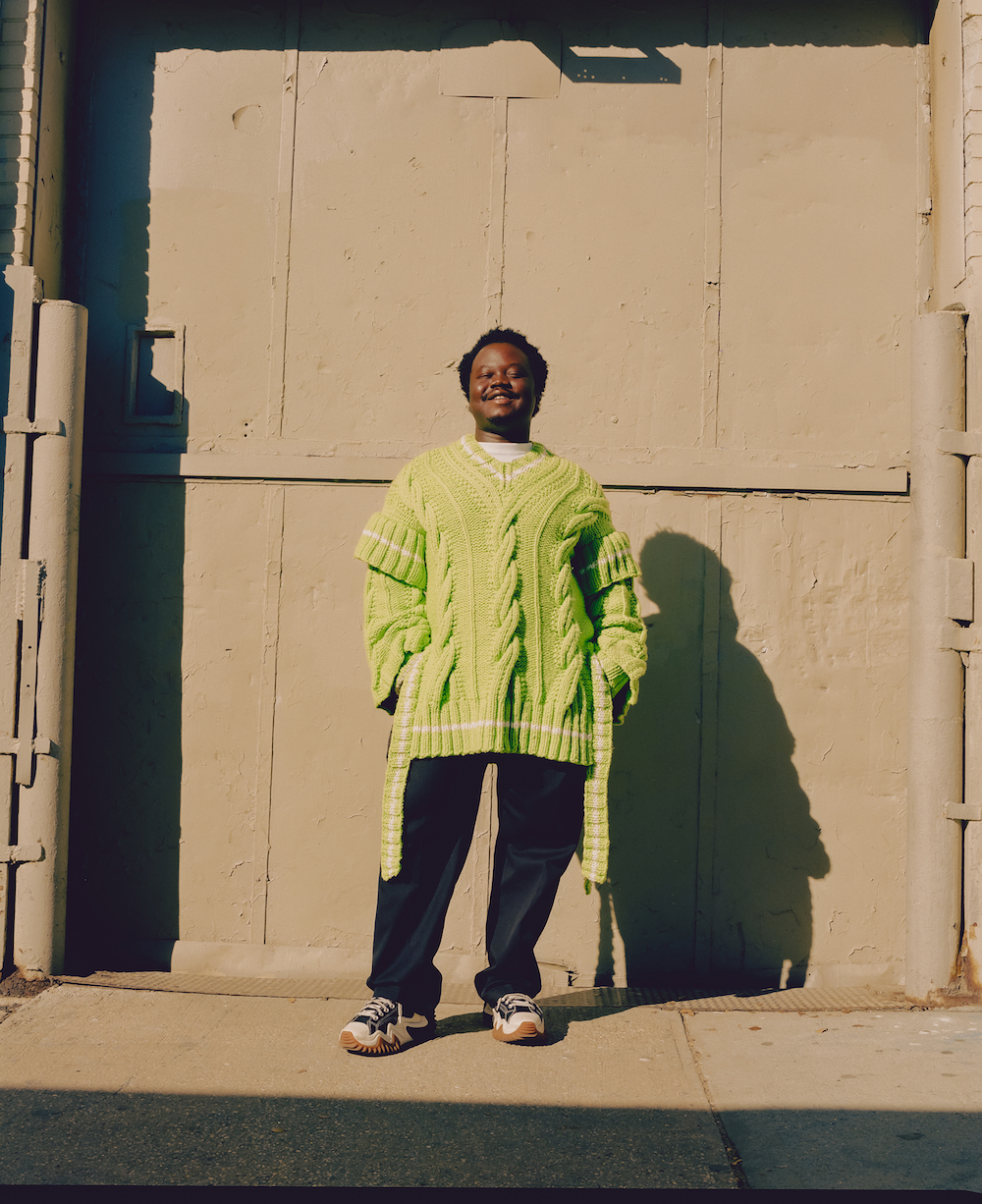
As we entered Agbobly’s intimate studio, yellow light shone through a large solitary window, greeting us as it touched the color-filled room full of Agbobly’s collection—balls of yarn, tools, and knitting machines that create the intricate works we now see gaining so much notoriety. For Agbobly, without love, there is no real art—the creative describes design as “a love language.”
Below, VMAN sat down with the Togolese designer to discuss their brand story, affinity to knitting, and the memories that they commemorate through design.
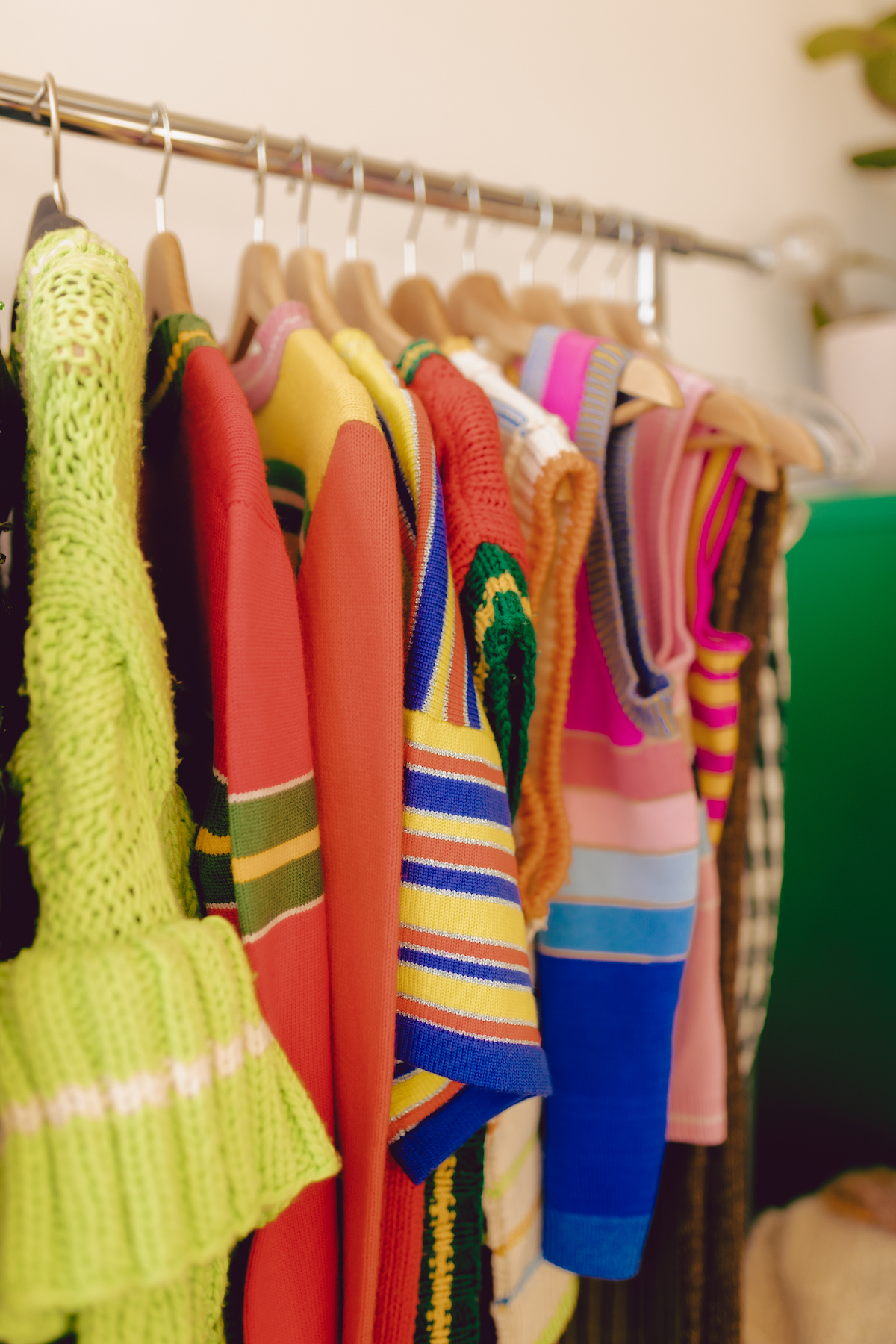
VMAN: How’d you decide on your brand name?
JACQUES AGBOBLY: To tell you that I have to start from the beginning, It came about at the start of the pandemic. I graduated from Parsons, and during that time, I was unhappy with the industry because I felt like there wasn’t any room for me. I had really great experiences in school, but a lot of them were also bad, to the point where I felt like if this is how the industry was, I didn’t see myself there. I’ve always had more of an emotional approach to creating. So, for me, knitting has always been something that brought me a lot of joy and was very therapeutic.
When I started a brand, I wanted [people] to visually see and know who was creating it and what it was without having to present [it] myself. It wasn’t supposed to be a brand, I just started releasing work, and people were purchasing from Instagram. It was honestly a way for me to survive during the pandemic when I didn’t have any jobs. I just came up with the name Black Boy Knits because I wanted you to know who was doing it at the time; visually, you’ll already know what it is and who’s doing it.
VMAN: You presented during NYFW just two years after graduating from Parsons. Do you feel like your education in design prepared you for the chaos of Fashion Week?
JA: Absolutely not. What was really interesting, and I’ve been telling a lot of people who are younger designers [and] who are still in school, that school is a bubble. It’s a great space to have free range to learn and mess up as much as possible, and don’t get me wrong, I love school. But I do think that you need to be in the ‘real world’ to really know how it is. Fashion Week in the industry [and] in general, felt very inaccessible. When I was in school, it didn’t feel tenable. A lot of it was because I didn’t see many people like me in that space. I wasn’t given the opportunity to be in that space. I was working four jobs while I was in school. So, I never got the opportunity to intern under anybody or learn under anybody because I needed to focus on gaining access to funds to continue my education and livelihood. So, I never had any experience working at Fashion Week.
This was the first time that I really got to be in Fashion Week [and] I don’t think I was prepared for it. I didn’t really learn how the industry was until I did Fashion Week; I think it was a great learning experience because it was a lot for me to see the feedback. This was the first live event that I’ve ever done for the brand. I didn’t do a show, I did a showroom. So, it was more intimate; people from all over my community got to see my clothes up front, touch them, feel them, and really got to interact with the clothing, which is my biggest goal. It’s different when you’re viewing it online, but when you’re in person, it’s another feeling and that was a great learning experience. Now when preparing for the next one, it’s really about building an ecosystem of support so that I’m not the one who’s dealing with everything all on my own.
VMAN: Why’d you fall in love with knitwear?
JA: At the time, I’d always wanted to do knitwear but growing up, one thing that I really loved was working with my hands. I grew up in Chicago [and] I was put in a lot of after school programs. I was born in Togo, but I moved to Chicago when I was nine. Chicago has such a great foundation for kids who want to become artists. So much of it was visual arts; I went to high school for visual arts, and I used to work with my hands. I’m used to taking time to do things, so I’ve always loved knitwear. But I didn’t have time to pick it up because I was often working so many jobs and always doing multiple things at once.
When I got to college, I took my first knitting class and I actually almost failed; I got a D in the class because I was working multiple jobs and I didn’t have the time. And that was the fire that I needed, it lit a fire under my ass. So the following semester, I took three knitting classes. And I was also working; I got a job with the knitting lab at school. So, I was constantly knitting, and I had no choice but to fall in love. You don’t even know when you’re doing something a lot, it’s almost like a dance. I did a lot of dance classes growing up and when I’m knitting, it almost feels like I’m dancing with the machine—almost like a romantic partnership in a way, where the machine’s not operating unless you’re operating it. It’s not automatic, but it can give you a lot and you must work with it. It’s like working within the confinements and the limitations of the machine. It’s a love language; I really love all my machines that I have, they each have quirks to them.
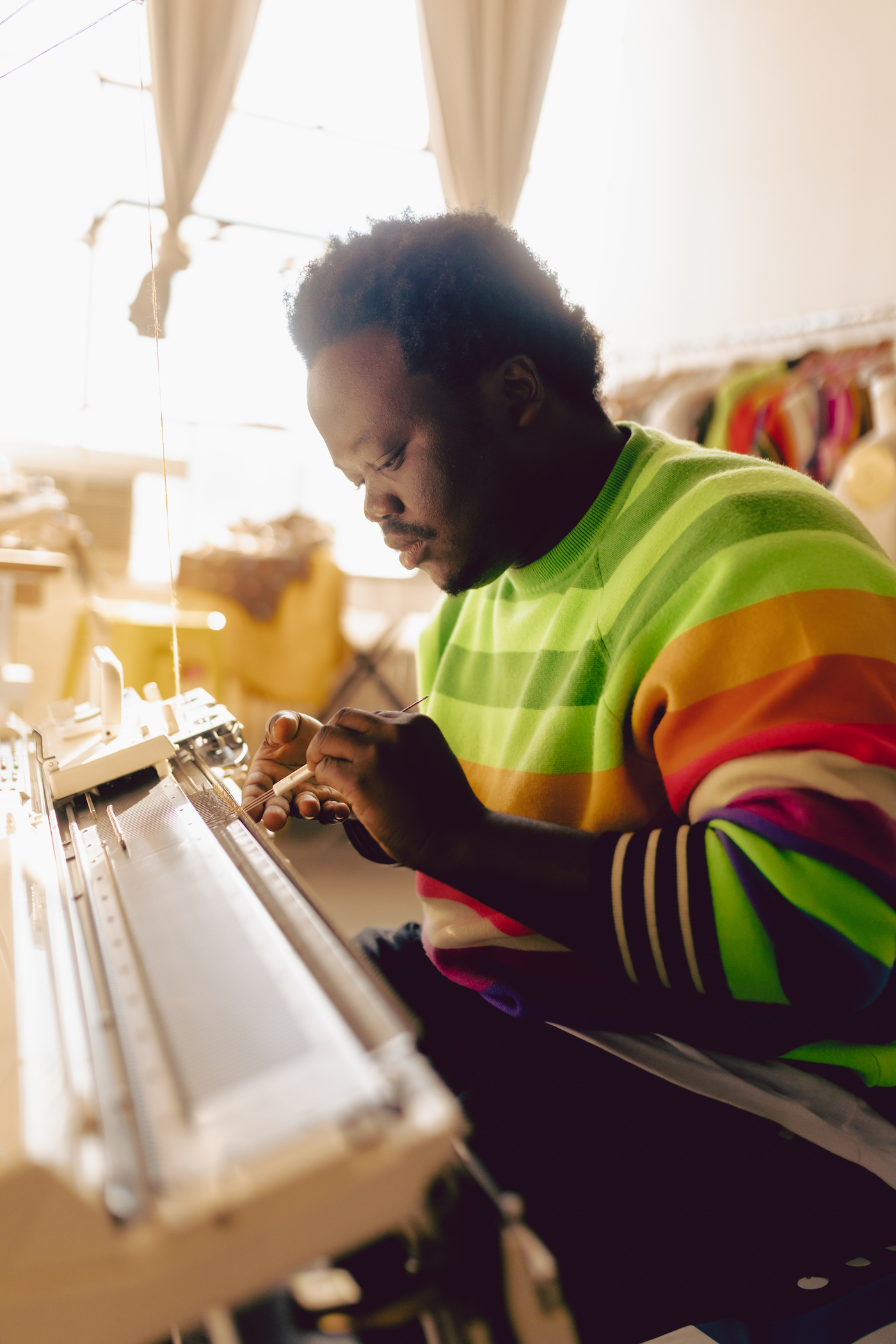
VMAN: How does your upbringing in Togo inform the way you design?
JA: It’s everything. It’s woven within the fibers of everything that I do. When I first moved to America, I struggled with the duality of my identity, having to figure out ways to navigate and negotiate between when to be American versus when to be African. I came here at a very young age, so the full understanding of Togolese culture was kind of taken from me. The work that I do, it’s about learning more of my culture.
I often work from photographs, specifically photographs of my mother when she was in Togo. There were photographs of her just living life with her siblings, something that I didn’t get to do with my siblings as much. So it’s really living and finding out about Togo vicariously through her. I didn’t live with my mom in Togo, my mom left when I was about three years old. She came to America first and worked here to bring the rest of us here. So, really, it was about living vicariously through the photographs and remembering what life was for me as well. Something that I really travel back to that I think is really cool about Africans in general is that we’re very patriotic. You meet an African person that will be like, “My country is the best,” or there’s that whole jollof rice debate between Nigerians, Ghanaians, and Togolese people.
VMAN: When you moved to America as a child, what was that adjustment process like?
JA: I remember we moved here, the exact date was July 11, 2007. I remember because 7-Eleven had a celebration where you could get free slushies on 7/11. I remember when we got off the plane and went through customs, all of the paperwork [and] the doors of the airport opening to get our car. I remember it was cold, it was the middle of July, and I was like, “It’s so cold.” I’m so used to the heat and in Chicago it was windy. So, I was like, “This is the coldest country in the world.” The greatest thing about moving here was that we didn’t go straight to school. We had the summer to acclimate which was a beautiful thing. I still remember that summer very well. I remember things smelling so differently than they did back home. We spent the first month watching a lot of SpongeBob. I learned English by watching SpongeBob. We lived on the West Side of Chicago in a really bad neighborhood, but my mom made it feel like it was the best thing in the world. Although there was a lot of violence in that space it’s where I first came to, so I hold that place very dear to my heart.
And then we moved into an assisted living program on the North Side of Chicago. That’s where I was really just encouraged to dream. We didn’t have a lot and I didn’t come from a lot, but we would have after-school programs where they would have tutors help us with our homework, and that’s when they would ask me, “What do you want to be when you grow up?” And that was the very first time that I had to think about that. So I had a very beautiful upbringing in America, [and] although there was a lot of trauma, that was a space where I felt like I could be the most me. And especially coming from an immigrant household, my mom would say as long as she didn’t have to pay for anything, you can be wherever you want to be. I was in a lot of dance, acting, and art classes. That’s where I was the freest.
VMAN: You make sure your identity is the throughline of your brand. How do you highlight the experiences of Black queer people in your work?
JA: By being me. Everyone wants to do fashion, there are so many designers out there. What you have that’s unique is your story and where you come from, and as long as you can communicate that as authentically as possible, that’s the best thing you can do. I think for me, I’ve always made work about myself because it’s not so much about the product but more about the research. It’s about finding myself in the work. My experience as a Black queer immigrant from Chicago is a very unique experience. I talk about it through the work that I do because that’s all I know, that’s my perspective. And if it resonates with other people, that’s the best thing in the world. And if it doesn’t, it doesn’t have to, it resonates with me.
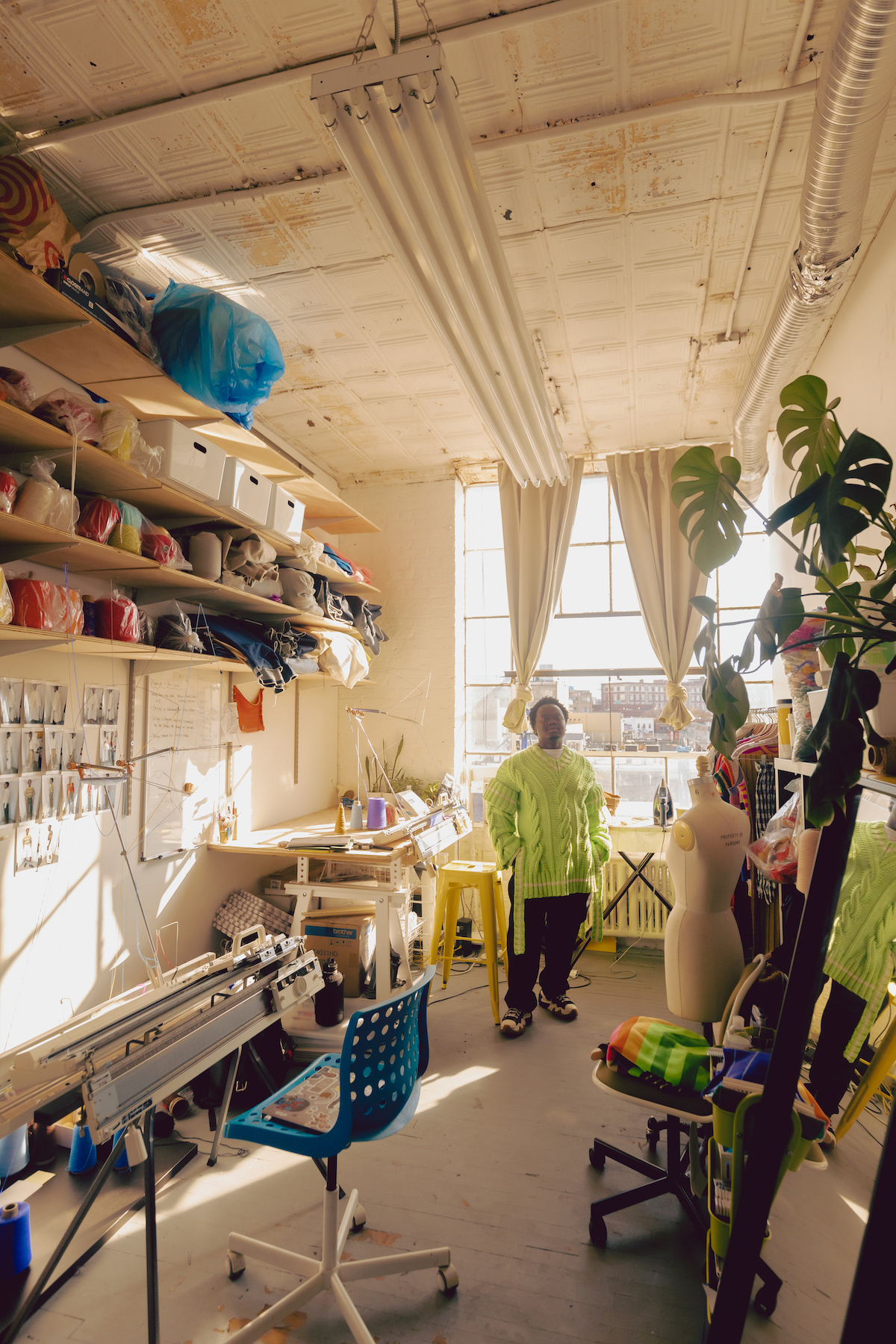
VMAN: You won the CFDA’s DHL Logistics award. What did that moment feel like for you?
JA: It was interesting because my brand is part of the CFDA/Vogue Fashion Fund this year and with that comes mentorship—I have a mentor who has been mentoring me, as well as funding to operate. Then the DHL Award came after that. I’m really excited about it because I feel like it’s going to allow me to have my work on a bigger platform. The whole point of the grant and the opportunity is to help expand your business internationally.
I’m really grateful to be in America and have my work here, but I really want to go back home and do something there. So I think starting that conversation and having the team at DHL support me in the way of advising me on how to operate on an international level and mentor me through that will be such a great thing. There are lots of laws and technical things that you don’t necessarily know about that you need to know about, and I feel like that’s what that team is there to do. I’m so grateful to have that support and opportunity.
VMAN: From graduation to now, where do you think you’ve grown the most as a designer? And what’s a goal you want to accomplish in the new year?
JA: The ways in which I have grown the most is really finding that niche. I think knitwear as it exists, there’s a lot of innovation in that space. I used to struggle with fashion because I like to take time and fashion doesn’t really allow for that. I used to think I had to create this big thing and expand in such a big way to really make an impact. Now I think about doing it authentically, doing it slowly, and keeping it to a scale that’s manageable for as long as possible. One thing I didn’t learn in school is the business side of things so I’m now tapping into that and learning about being more consistent in releases, having a team represent me, and building a team. We weren’t taught any of that in school. We were just taught how to take ideas, make them into a design, take photos, present, and then move on to the next thing. Now it’s like, “This collection is important, how do I get it on bodies?” [Also] learning about production, stylists pulls, all the parts of the industry that you don’t necessarily get to learn in fashion school. I’m learning [and] although it may be terrifying, I’m always interested in learning something new.
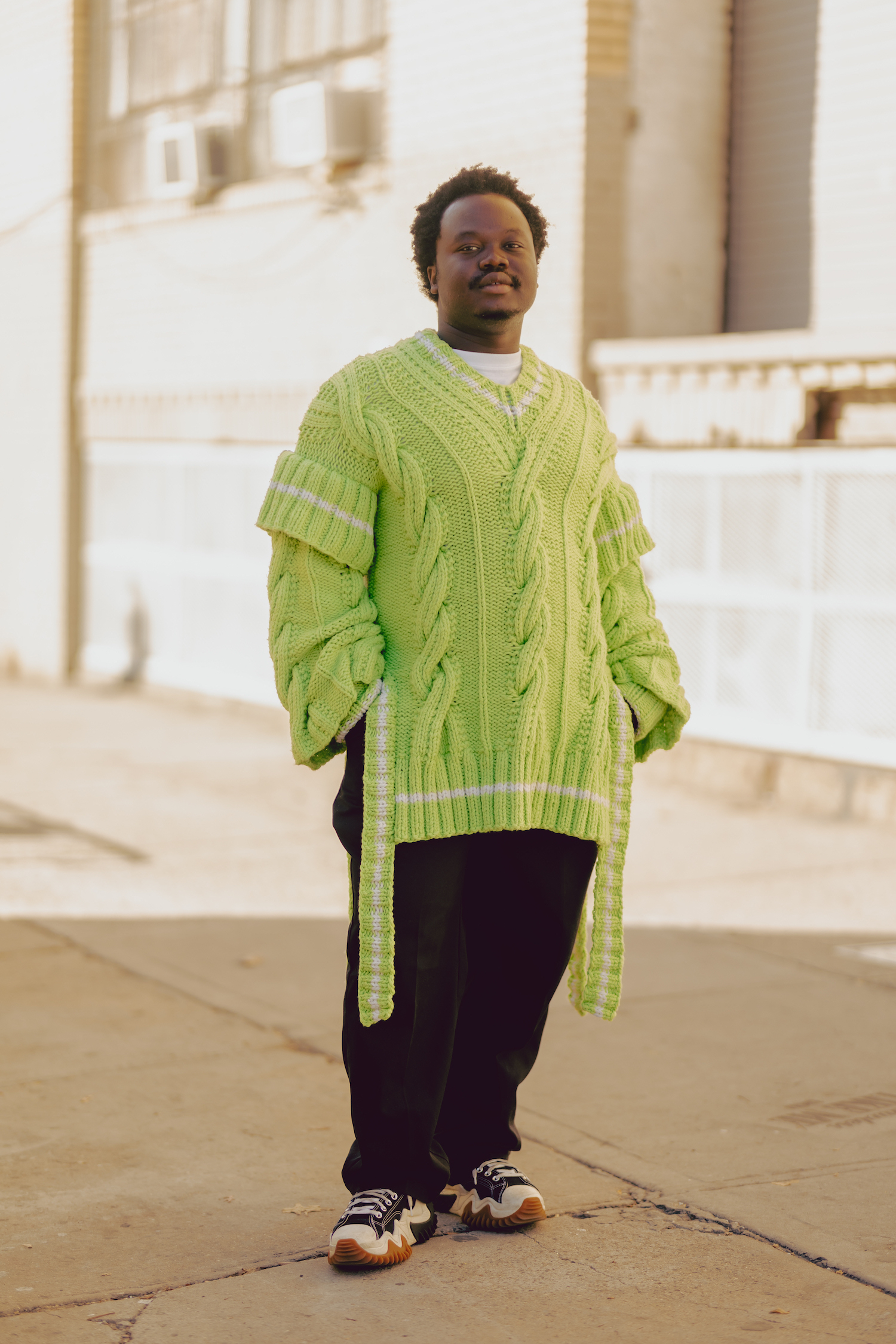
VMAN: Is there someone that you’ve looked up to creatively?
JA: My aunt Love. Her name was Love, and she passed away. I didn’t get to meet her but I heard stories of her through my family. She is someone who was a great dancer so there are lots of photos of her dancing, and these photos are always on my mood board. From the stories that my family will talk about, she was someone who was a very free-spirited, creative person. I think I share a lot of attributes with her, even though I didn’t get to know her. So, that’s definitely one of my biggest inspirations creatively.
Growing up, I looked up to many designers as well. Karl Lagerfeld, I thought that he was such a creative genius in the way that he valued craft because at the core of it, that’s where my interest lies, in making things that take time. With my work, I really want people to own it forever and pass it on to their friends and family. I think that European houses have a way of doing that, they create pieces that are going to last you forever. I looked up to Karl Lagerfeld, Alexander McQueen, and all the greats. But even today—thinking about designers who are doing it now that I love—I think people should receive their flowers when they’re alive. Telfar [Clemens] is a huge inspiration. Raul [Lopez], from Luar, who I literally met a couple of days ago. I’ve known about his work for a long time and he just won Accessories Designer of the Year [at the 2022 CFDA Awards]. Edvin Thompson from Theophilio, Taofeek Abijako from Head of State. A huge inspiration is Christopher John Rogers, he’s someone who has been a great mentor. I worked for him last year in production and I learned so much from him. He actually wrote my letter of recommendation for the CFDA/Vogue Fashion Fund. All my friends who are in my creative circle are creative geniuses and are about to blow up in a matter of time. I have a very strong network of creative people around me that are inspiring.
Discover More
